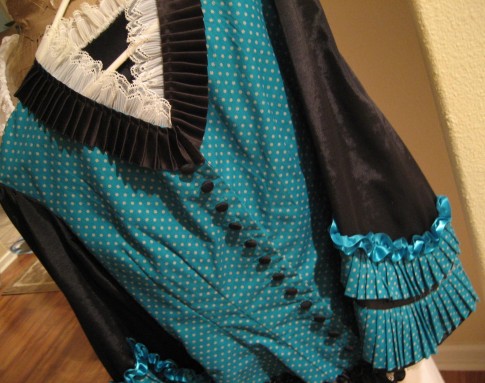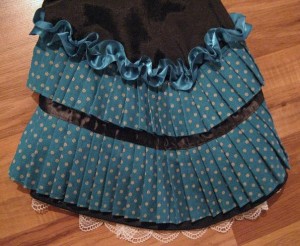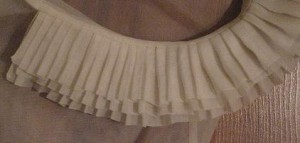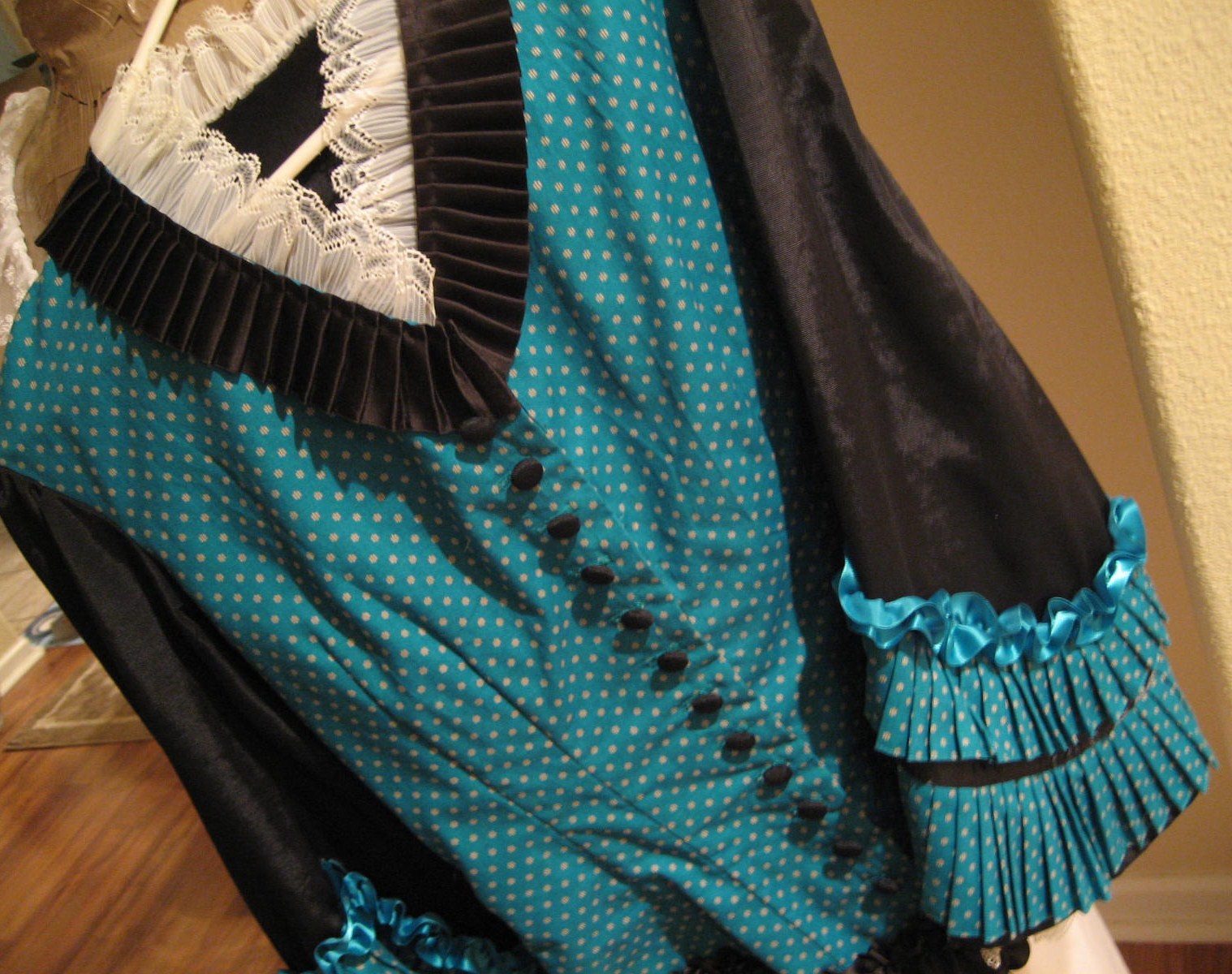
Want to know the secret to keeping your finely pleated trim and garment areas looking crisp and perfect for years? Use this simple tip and you’ll soon say: “Oh that’s how they made it look that way!”
The above bodice is an 1873 reproduction made from a mix of a Truly Victorian bodice pattern with the sleeves from an Ageless Pattern and the trim modeled after a Godey’s plate. The bodice was made in March 2003 with the photo taken in February 2011.
And look at those pleats on the sleeves and neckline! Perfect after all those years and numerous wearings.
About this time I got my hands on a Perfect Pleater. Oooh! for beautiful, perfectly spaced pleats. And how absolutely ideal for bustle trimmings.
My first set of those teal sleeve ruffles was challenging to say the least. After fiddling with the fabric in the grooves of the Pleater, I pressed then removed.
… And all my pleats came out. What the heck?
So I then carefully tried to reconstruct the pleats by pinning the strip to my ironing board and pressing again. Better, but still I could see the pleats loosing their straight pressed edge after bouncing around in the dress for a few hours.
Turning to my bookshelf I perused my general sewing books and came across a gem of a tip that has completely changed my sewing of pleated things.
~Vinegar~
Yep. That common household liquid that cleans and freshens everything from vegetables to toilets. The sewing tip was to use white vinegar when pressing garments. huh, Really?
So into a spray bottle with water and a bit of vinegar I poured then squirted it right on my fabric pinned to my board. I pressed again. Then let cool.
…
…OMG! Look at those pleats! Those aren’t going anywhere.

I then began using this simple solution on every pleated thing – even older projects. I couldn’t believe the results and that I never knew of this secret solution.
To get your pleats to come out fantastic too:
- Use anywhere from a 2:1 to 10:1 ratio of water (more) to vinegar (less amt.)
- Fill a spray bottle first then add the vinegar.
- The strength of the scent of the vinegar will depend on how much you use but the smell will fade over time and within just a few hours.
- Pleat up the fabric or trim in the Perfect Pleater, with pins or cards.
- Spray solution directly onto cottons or linens.
- Spray solution onto a press cloth and lay the cloth over the pleats.
- PRESS pleats with iron on the fabrics heat setting; do not ‘iron’ the pleats by moving the iron – press down and hold
- LET COOL! This is the one best hint to pay attention to.
- Move trim out of the pleater and/or unpin the pleats; press again if desired
- Apply to your costume and look beautiful!
Leave a comment on how this simple solution has worked for you.
What projects have you used a vinegar solution on?

(If Annie’s doesn’t have the Pleater, try Amazon, Etsy and eBay.)


very helpful and interesting blog. I am putting knife pleats in a silk trousers and want to make sure they stay in so any suggestions would be welcome.
Take a swatch of your silk and pleat with lightly spraying a mix of white vinegar and water then pressing. (Use more vinegar than water as water can leave spots on silk; you might try all vinegar at first.)
May be a dumb question, I’m very new to this sort of stuff, but do the pleats last through machine washes? Say if i were to use this on a synthetic taffeta or a polycotton mix, would the creases last at all if i were to machine wach instead of bringing it to the dry cleaners?
On synthetics, no. Washing will remove the pleats. That said, pleating polyester is really hard to do for nice, crisp pleats. There’s nearly always some softness that remains in the pleat folds. And my focus on using vinegar for pleats is for use on historical projects, which are rarely washed but only spot cleaned and aired out. (Vodka spray is recommended for airing out.) The vinegar works best on natural fibers.
This is fantastic advice! Quick question, I am looking to pleat taffeta and have it stand up straight and stiff. Gonna start with the vinegar mix and starch. Any other suggestions?
If it’s silk taffeta you might not even need the vinegar as taffeta is so tightly woven it can stand up on its own. If you still want to use the vinegar, spray onto a press cloth, lay the cloth on the taffeta pleats then press. Don’t spray the vinegar directly onto the silk as it may spot. Test first, of course. I’d also be hesitant to starch taffeta… again, based simply on the natural stiffness of it and that it is silk. Good luck with your pleats!
My best tip for maintaining pleats- fold clothing article lengthwise- pull into a stocking. Knot top & bottom put in machine on gentle wash. Takeout of stocking- shake – hang to dry- place back in stocking to store.
How can you use vinegar to pleat Taffeta? I m new to trying to use this fabric and it has been a learning experience. One thing I read is that taffeta SPOTS…wateris the enemy. SO how would you use vinegar to set the taffeta pleats?
It’s depends on your specific taffeta fabric. Definitely test on a scrap first. However, silk taffeta pleats up beautifully with no need for vinegar. If you want to go ahead and use vinegar I’d only use a light spray to try and avoid spots.
Do you have any tips for pleating silk
In regards to how specifically? I’ve got another article on pleating tips and one on pin pleating too. For any fabric you can use the Divide & Conquer method.
i am making my wedding dress and decided to go all out Victorian (because i am a mad woman), so the hem of my skirt will have a pleated ruffle, but to do this i have to pleat at least 8 1/2 meters of silk dupioni. i have made a pleating board and borrowing an iron press from a friend, but i am still very hesitant to start. any advice you have would be greatly appreciated
Have you looked at my Divide & Conquer post? If you have a certain length to pleat up to a certain length on the skirt then this method would help. Otherwise pleat on the pleating board then attach to the skirt ignoring any extra pleated part you may end up with. Silk presses nicely and you probably won’t need a vinegar solution on it. Congrats and good luck!
Thank you for the extremely helpful tip. It really does work.
I have a silk full length skirt that I love but after wearing it to the theater and sitting for hours , the back has become unpleated. My dry cleaner said it cannot be saved or fixed. It is very transparent and thin.
How can I save this as I do not sew and am not the best with an iron even though I have a wonderful Rowenta steam iron.
Can you advise me?
Thank you in advance
Thank you in advance.
It merely needs to be strongly steam pressed back into place. Depending on their stiffness, thin materials don’t always hold their pleating structure. Go to an independent/family-owned dry cleaner (not a chain store) or even alterations business to have them press back into place. You might also try a bridal shop and get their alterations person to press the pleats back into place. Good luck!
Jennifer, I have 472 yards of 4.5″ trim to pleat for the hem of a dress I”m re-making. I want 1/2″ pleats. The Perfect Pleater is very hard to use because my silk is very thick and heavy and the pleater is only 21″ long. At this point I’ve only managed a few feet and there is SO much more to do Is there any way to speed this process up? I’ll be weeks before it’s ready to continue.
HELP!
If you haven’t seen my post on pin pleating then I’d recommend that method to help speed it up. Letting the fabric cool completely in a Pleater does take a LONG time.
Question, does anybody know if this vinegar method works for pleating wool
I’ve not tried it on wool. Wool pleats need lots of pressure and heat to set; most of the time they are soft though. I’d test and see what happens!
i know your post is 3 years old but i will say if you can get a poly-wool blend fabric, it makes great pleats and will last. wool by itself does have soft pleats unless you get some real professional heat setting treatment (like SiroSet which is specifically used for wool).
I ‘ve used vinegar several times to set creases in slacks and make them sharp and permanent. It works well with cottons, rayons, and polyester blends. I also use it when I want a sharp edge on a hem I’m turning up.
Nothing I’ve tried seems to set a permanent crease in linen slacks, though, as most of the crease disappears when they’re washed.
By the way, if you have a pleat or a crease on fabric where you DON’T want one, such as a hem you’re letting down, the vinegar solution and ironing will make the crease disappear. It sometimes takes a couple of tries, but it will work.
I found lots of instructions online to permanent set pleats in polyester. . . what other fibers have you had successful results with?
Do I press out the pleats on the hem that I am turning under and then try to put the pleats back in? They are so narrow.
Look, honest opinion: they’re freaking out over nothing. I’ve hemmed and rehemmed mine and my sister’s catholic school uniform skirts. Which were pleated as all get out. If you’re careful and watch the pleats as they go through your machine so they don’t get sewn together by accident you’ll be fine without ironing out and ironing back in your pleats.
Yes, it is a pleated skirt. I want to hem the whole skirt all the way around.
You’ll need to flatten out the pleats and hem then re-press the pleats. Good luck!
I might add that the pleats are a little less than 1/2″.
Can I hem a polyester skirt with knife pleats? If so, how? When I turn in the hem, the pleats are opposite on the inside. I am so afraid of ruining my skirt.
The knife pleats are already in place?? It’s best to do any hems THEN pleat whatever section you want to pleat (ruffle, skirt, etc.).
I find it’s easier to rip the waistband off the skirt, trim the amount I want the skirt shortened off the top, then reattach the waistband. With 1/2 inch pleats, I’d also run a line of basting stitches along below the existing waistband about where you want the new placement BEFORE you remove the waistband. That will hold the pleats in place so you don’t have to pin every pleat in order to put the waistband back on.
“Letting it cool” Do you press the entire garment and then let it cool or do you press a section and let it cool before moving it to press the next section.
This is helpful. I would never have dreamed of using vinegar to set pleats.
In talking about pleating here, it’s only pressing the pleats then letting them cool before moving on to the next section. I’m not pressing the entire garment at this point. But whenever pressing a garment it’s a good idea to let a section cool a little before moving it so wrinkles don’t reappear.
Is the material doubled or is it single layer it looks doubled
The teal cotton here is single layer. However, you can use single or double fabric as desired for whatever look you are going for.
just a small question… So When you heat set the polyester fabric with vinegar, what is the iron setting? did you set the temperature higher than the normal polyester setting to make sure the pleat stays?
You always have to be very careful with heat and polyester as too much will melt the fabric fibers. Keep the iron setting at poly and test. Add steam. Turn up the heat very slowly and always test on a swatch. Synthetics will not always take the vinegar well. In my experience the pleats don’t set as hard in creases making for softer looking pleats. Simply the nature of the fabric. Vinegar and water will stain acetate, so I recommend spraying a press cloth with the vinegar rather than spraying the fabric directly.
Your blog is soooo helpful, thank you!
Looking for older historic uses, do you think a final rinse in vinegar solution and then drying the folds in might have been used to give similar permanent creases, especially to linen?? I am thinking about the Viking pleated under-dresses and looking at apparent texture in Roman statues which could be interpreted as pleats rather than wrinkles
Certainly is a viable theory. I don’t study clothing that far in antiquity so can’t say for sure.